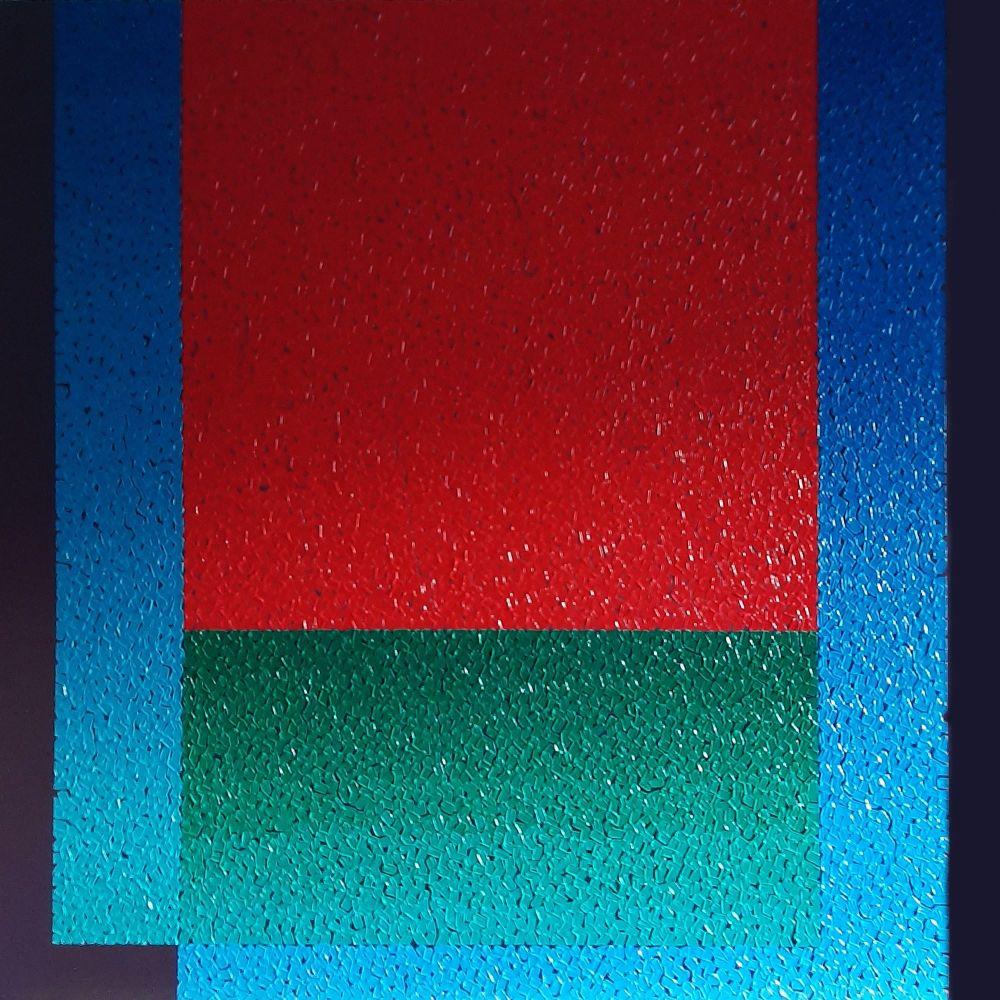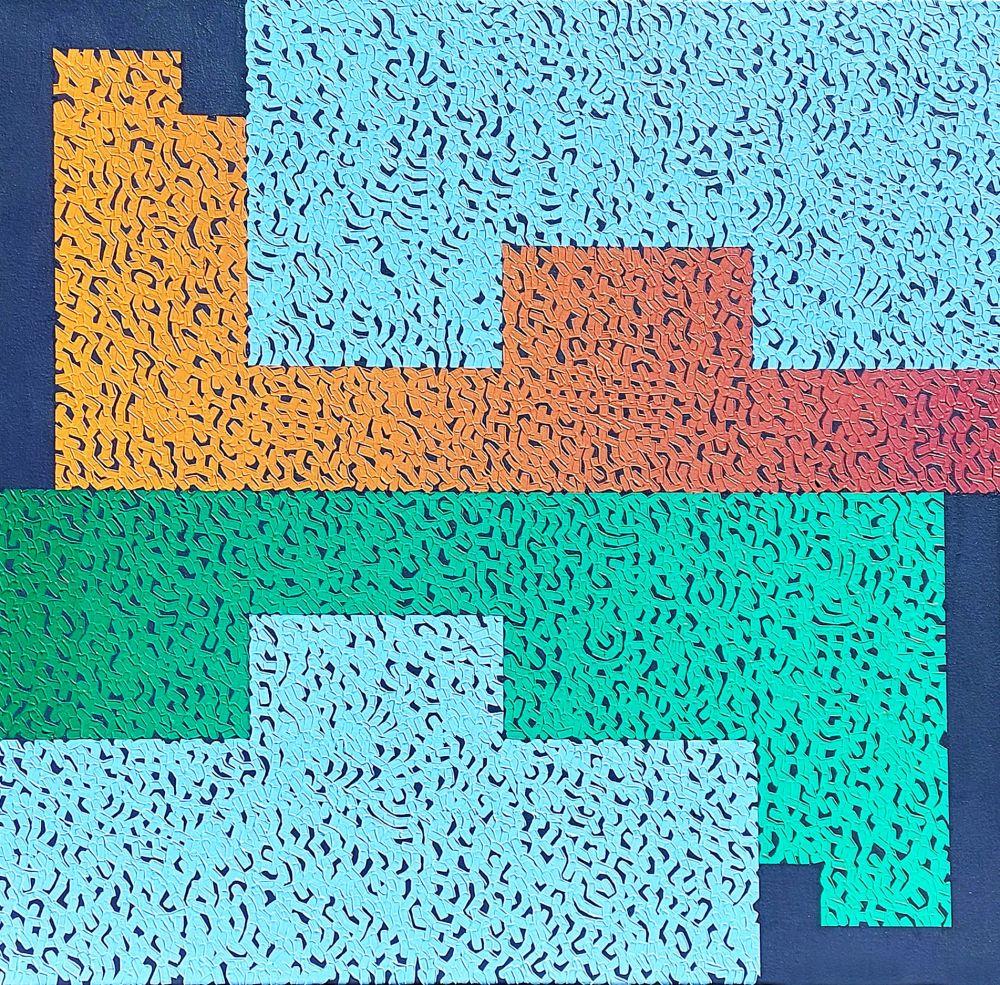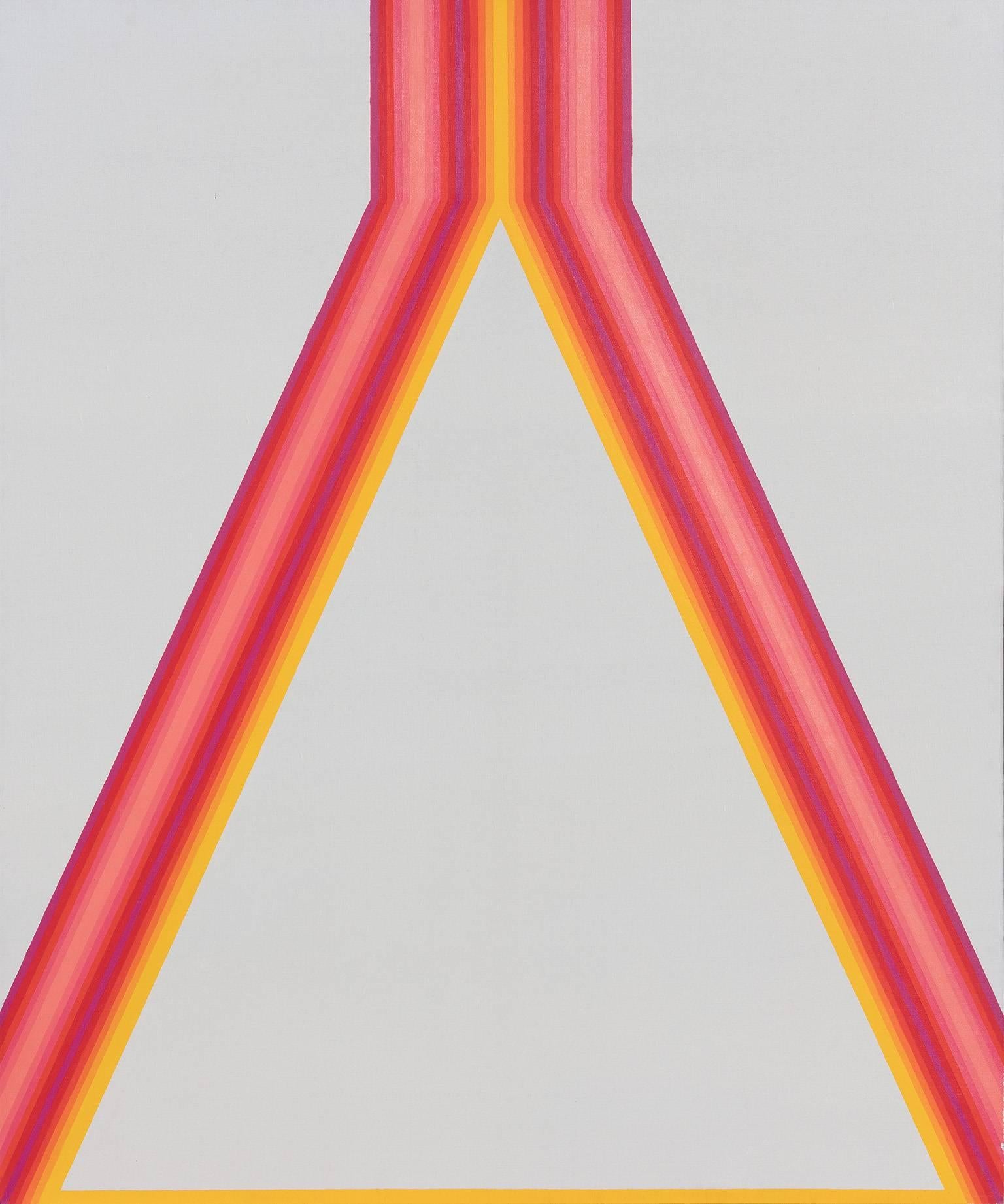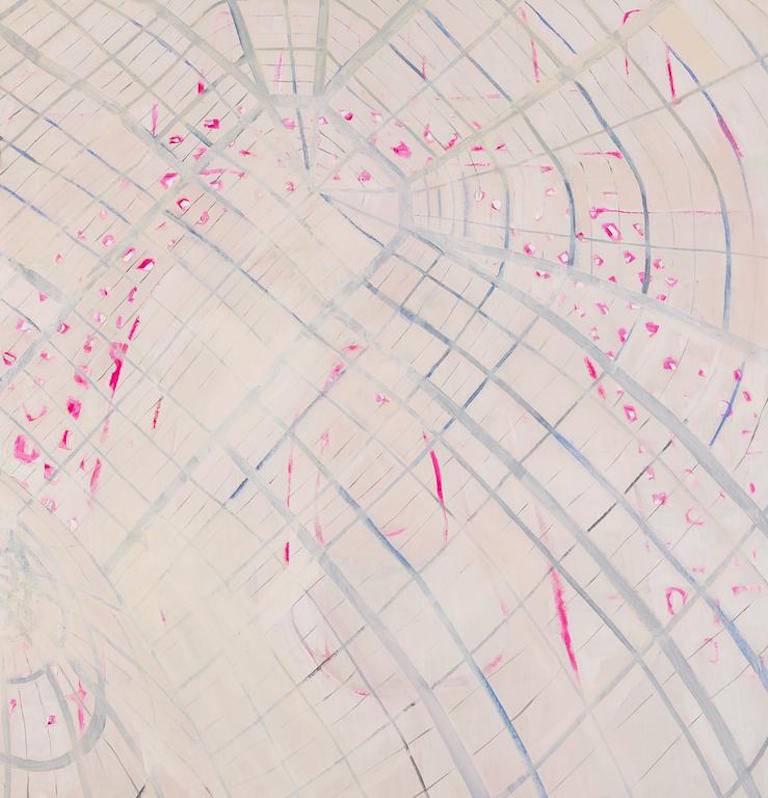Items Similar to VENUS I by Auguste Herbin - Abstract, geometric painting
Want more images or videos?
Request additional images or videos from the seller
1 of 9
Auguste HerbinVENUS I by Auguste Herbin - Abstract, geometric painting1945
1945
About the Item
VENUS I by Auguste Herbin (1882-1960)
Oil on canvas
100 x 81 cm (39 ³/₈ x 31 ⁷/₈ inches)
Signed and dated lower left, herbin 1945
Provenance: Private collection, Stockholm
Galerie des Etats-Unis, S.Stoliar, Cannes
Sotheby's London, 2002
Dorval Gallery, Lille
Private collection, France
Literature: Geneviève Claisse, Herbin, Catalogue Raisonné de l'Œuvre Peint, Paris, 1993, no. 846, (illustrated in black and white p. 429)
Exhibition: Cannes, Galerie des Etats-Unis, 1965, no. 29
Artist biography:
Auguste Herbin was a French Cubist and later abstract painter, celebrated as a pioneer of non-figurative, 'radical geometric' abstraction in France while also associated with movements including Orphism, Purism and New Objectivity.
Born in Quiévy, a small village near the Belgian border, Herbin was the son of a workman. He attended the Ecole des Beaux Arts in Lille where he produced post-Impressionist works from 1898 to 1901, before moving to Paris and working in isolation for several years. After visiting exhibitions of Vincent Van Gogh, Paul Gauguin and Georges Seurat, he joined the Fauvist movement.
Gradually, Herbin turned to Cubism. Encouraging this transition was Cézanne's 1907 retrospective at Salon d’Automne and a move in 1909 to the Bateau Lavoir, where his studio was in close proximity to those of Pablo Picasso and Juan Gris. Though his first Cubist works appear in 1913, Herbin’s first one-man exhibition was at the Galerie Clovis Sagot, Paris in 1912.
From 1917 to 1921, Herbin moved to "an ornate phase of Cubism akin to folk art". This work contrasted from that of 1922 to 1925, when he reverted to a more figurative style (a tendency echoed in the oeuvres of Fernand Léger and Picasso during the post-war era). Herbin then settled back into abstraction in 1926, applying himself to organic, often spiral-like forms, before once again pursuing 'pure' geometric abstraction.
Herbin co-founded the Salon des Surindépendants in 1929. Two years later, along with Georges Vantongerloo, Theo van Doesburg, Jean Hélion, Hans Arp and František Kupka, he founded the artist association Abstraction-Création which strove to combine various non-figurative styles. Herbin and Vantongerloo published five issues of an eponymous journal between 1932 and 1936.
From 1938, Herbin's interest in the Italian Trecento led him to more concrete, strictly two-dimensional painting and simple geometric forms. After the Second World War, the artist was co-founder and vice president (also president from 1955) of the Salon des Réalites Nouvelles.
Herbin developed a compositional system called "alphabet plastique", based on the structure of letters, in 1946. This geometric vocabulary of coloured shapes partly derived from Goethe's Farbenlehre or Theory of Colors as well as Rudolf Steiner's anthroposophical writings. It was based on Herbin's conviction that synaesthetic parallels exist between letters, musical sounds, colours and forms, such that words and tones can be expressed in painting. According to his "alphabet plastique", for example, the letter C is dark red, has the form of a circle or square and corresponds to the solfège syllables "do" and "so". For his work during this period (Vierge, Homme et Femme, Foetus, Guerre et Paix and Abri, e.g.) Herbin interpreted terms and expressions loaded with meaning. In 1949, he published his system of "alphabet plastique" as well as colour theories in L'art non-figuratif non-objectif, which took on great significance for a younger generation of artists.
During the 1950s, Herbin was an active designer of tapestries. A lateral paralysis in 1953 forced him to learn painting with his left hand.
Herbin died in Paris at the end of January, 1960. One painting, Fin, remained unfinished.
Herbin’s architectural approach and colour effects have made his pre- and post-war work extensively known in the international art world. Between 1955 to 1972, his work was exhibited at documenta I, II, V and VI (in the last programme, Harald Szeemann put it in the category of Individual Mythologies). Herbin was represented at the Guggenheim Museum, New York in 1979 and in the exhibition Positionen unabhängiger Kunst in Europa um 1937 at the Kunstsammlung Nordrhein-Westfalen in Düsseldorf in 1987. A retrospective at the Museum Haus Konstruktiv was held in 2014.
- Creator:Auguste Herbin (1882-1960, French)
- Creation Year:1945
- Dimensions:Height: 39.38 in (100 cm)Width: 31.89 in (81 cm)
- Medium:
- Movement & Style:
- Period:
- Condition:
- Gallery Location:London, GB
- Reference Number:1stDibs: LU261212871402
About the Seller
5.0
Recognized Seller
These prestigious sellers are industry leaders and represent the highest echelon for item quality and design.
Gold Seller
These expertly vetted sellers are highly rated and consistently exceed customer expectations.
Established in 1964
1stDibs seller since 2015
95 sales on 1stDibs
Typical response time: 8 hours
Associations
Society Of London Art Dealers
- ShippingRetrieving quote...Ships From: London, United Kingdom
- Return PolicyA return for this item may be initiated within 7 days of delivery.
More From This SellerView All
- Memories by Lélia Pissarro, 2013 - Oil on Canvas PaintingBy Lelia PissarroLocated in London, GBMemories by Lélia Pissarro (B. 1963) Oil on canvas 120 x 60 cm (47 ¹/₄ x 23 ⁵/₈ inches) Signed lower right, Lélia Pissarro Signed, titled and dated May 2013 on the reverse Executed i...Category
21st Century and Contemporary Abstract Abstract Paintings
MaterialsCanvas, Oil
- Rhino sauvage sous la pluie, ta force mataille by Lélia Pissarro - ContemporaryBy Lelia PissarroLocated in London, GBRhino sauvage sous la pluie, ta force mataille by Lélia Pissarro (b. 1963) Acrylic, oil and resin on canvas 146 x 114 cm (57 ¹/₂ x 44 ⁷/₈ inches) Signed lower left, Lélia Pissarro Si...Category
21st Century and Contemporary Abstract Abstract Paintings
MaterialsCanvas, Resin, Oil, Acrylic
- Roger Howard at Ladywood by Lélia Pissarro -Contemporary abstract painting, 2021By Lelia PissarroLocated in London, GBRoger Howard at Ladywood by Lélia Pissarro (b. 1963) Acrylic, oil and gold powder on canvas 100 x 100 cm (39 ³/₈ x 39 ³/₈ inches) Signed lower left, Lélia Pissarro Executed in 2021 ...Category
21st Century and Contemporary Abstract Abstract Paintings
MaterialsCanvas, Oil, Acrylic
- Rhino sauvage sous la pluie, ta force ma taille by Lélia PissarroBy Lelia PissarroLocated in London, GBRhino sauvage sous la pluie, ta force ma taille (b. 1963) Acrylic, oil and resin on canvas 146 x 114 cm (57 ¹/₂ x 44 ⁷/₈ inches) Signed lower left, Lélia Pissarro Signed and titled on the reverse Provenance Private collection Literature Lélia Pissarro, The Colours of Silence, London, 2010, p. 58 (illustrated) This work is accompanied by a certificate of authenticity from the artist. Artist biography Born in Paris in 1963, Lélia is the third and youngest child of Hugues-Claude and Katia Pissarro. She was raised, however, in the loving care of her grandparents Paulémile Pissarro, Camille’s youngest son, and his wife Yvonne, in Clécy, Normandy. From a young age, Lélia’s interest in drawing and painting was nurtured by her grandfather while she sat beside him at his easel, captivated. He taught her the fundamental Impressionist and Post-Impressionist techniques he had learnt from his father and brothers before him and watched as her skills blossomed rapidly. Standing readily on the shoulders of giants, Lélia sold her first painting to New York art dealer Wally Findlay, when she was only four years of age. When Lélia turned 11 she moved to Paris to live with her parents where, with the guiding support of her father’s teachings she began to broaden her skill sets. Under the watchful eye of her father Hughes Claude Pissarro, she became exposed to new environments and learnt to experiment with abstract styles and subjects. At age 14 Lélia submitted some of these works to the exhibition ‘Salon de la Jeune Peinture’ at the Luxembourg Museum in Paris. Being underage, however, she had to submit these works secretly under the pseudonym Rachel Manzana Pomié. With her parents dividing their time between France and California, Lélia found herself moving between Tours, Paris and San Francisco, all the while studying fine art and psychology at the University des Beaux Arts. She eventually settled in Paris to teach art at the Moria School and study oil painting conservation under the guidance of a teacher from the Louvre museum. During this time she began to present her work in solo exhibitions in Paris, Lyon, Mulhouse and Rennes. In 1988 Lélia married English art dealer David Stern and moved to London. Their three children Kalia, Lyora and Dotahn, all paved their own way in the art world. From 1995 Lélia participated in a series of exhibitions entitled Pissarro – The Four Generations, which were held in galleries in London, Tel Aviv, Boston, Austin, San Francisco, Cleveland, Milwaukee and Los Angeles as well as a number of museums in Japan in 1998 and the Museum of Art in Fort Lauderdale, Florida in 2000. In 1999 Lélia also became one of the founders of the Sorteval Press, a group of artists dedicated to developing techniques in etching and printmaking. Their first exhibition took place at the Mall Gallery in London. In 2005 following a long break in painting because of cancer, Lélia started a journey into modern art creating a number of different series: Circles, Shoes, Animals, exploring these until she reached the point of abstraction and minimalism. Developing innovative techniques, she began incorporating in her work new materials such as gold, wax and encaustic paint. To coincide with a major exhibition at Stern Pissarro gallery...Category
21st Century and Contemporary Abstract Abstract Paintings
MaterialsCanvas, Resin, Oil, Acrylic
- Eros by Lélia Pissarro - Contemporary Abstract paintingBy Lelia PissarroLocated in London, GBEros by Lélia Pissarro (b. 1963) Acrylic, oil and resin on canvas 100 x 70 cm (39 ¼ x 27 ¼ inches) Signed lower right Lélia Pissarro Signed and titled on the reverse Literature Lél...Category
21st Century and Contemporary Abstract Abstract Paintings
MaterialsCanvas, Resin, Oil, Acrylic
- Untitled by Anish Kapoor - 2 part painting, Abstract, ContemporaryBy Anish KapoorLocated in London, GB*UK BUYERS WILL PAY AN ADDITIONAL 5% IMPORT DUTY ON TOP OF THE ABOVE PRICE Untitled by Anish Kapoor (b. 1954) Oil on canvas Overall dimensions: 122 cm (48 inches) composed of 2 par...Category
Early 2000s Abstract Abstract Paintings
MaterialsCanvas, Oil
You May Also Like
- Modus 1 - Colourful Geometric Abstraction: Oil on CanvasLocated in London, GBColin Lawson says "I work primarily with oil on canvas. Attention to detail, precision, and accuracy in the application of pigment is my main concern when constructing the surface of...Category
2010s Abstract Geometric Abstract Paintings
MaterialsCanvas, Oil
- Modus 7 - Colourful Geometric Abstraction: Oil on CanvasLocated in London, GBColin Lawson says "I work primarily with oil on canvas. Attention to detail, precision, and accuracy in the application of pigment is my main concern when constructing the surface of...Category
2010s Abstract Geometric Abstract Paintings
MaterialsCanvas, Oil
- Orange CircleBy Paul ReedLocated in Saratoga Springs, NYSigned & dated Verso. 1965 Paul Reed in 1970. He favored “staining” untreated canvas. Paul Reed, the last surviving member of the Washington Color School, who explored the complexities of color and form in vibrant bio-morphic and hard-edge abstract paintings, died on Sept. 26 at his home in Phoenix. He was 96. His death was confirmed by his daughter, Jean Reed Roberts. Mr. Reed acquired his public identity as an artist when he was included, along with Gene Davis, Kenneth Noland, Morris Louis, Thomas Downing and Howard Mehring, in “The Washington Color Painters,” a landmark traveling exhibition that began at the Washington Gallery of Modern Art in 1965. All of the other painters had been shown, the year before, in “Post-Painterly Abstraction,” a 31-artist exhibition at the Los Angeles County Museum of Art organized by the critic Clement Greenberg in an effort to write a new chapter in the historic march of abstract art. Like his fellow Washington artists, Mr. Reed rejected the hot, gestural approach of Abstract Expressionism and explored color and abstract forms in a cooler mode. Working with diluted acrylic paint, in discrete series that methodically explored formal issues, he created luminous fields of color by letting the paint bleed into, or stain, untreated canvas. “I have a saying: Pollock dripped, Frankenthaler poured,” he told The Washington Post in 2011, referring to the artist Helen Frankenthaler. “Morris Louis poured. Howard Mehring sprinkled. I blot.” In his first stained series, “Mandala,” color radiated from a circular central image. The nearly 100 paintings in his “Disk” series, which he called “a matrix for exploiting color,” consisted of a central circle and two triangles positioned at the corners of the canvas. Over the next decade he moved to hard-edge geometric zigzags and stripes in the vertical “Upstart” series, color grids and shaped canvases that allowed for more complex experiments in form and color relations. He also made welded steel sculptures and, in the “Quad” series of the 1980s, collaged photographs. “Reed was, in a sense, the ‘little master’ of that first batch of Washington colorists,” the critic Benjamin Forgey wrote in The Washington Post in 1997. “He was a latecomer — he didn’t turn seriously to painting until he was in his mid-30s — but he never considered becoming anything other than an abstract painter. And when he was ready to show, in his early 40s, he was a very good abstract painter indeed.” Mr. Reed gave himself a more modest assessment in an interview with NPR last year. “I’m sort of low man on the totem pole of that group of six,” he said. Paul Allen...Category
1960s Abstract Geometric Abstract Paintings
MaterialsCanvas, Oil
- Dichotos - Historic Yellow and Red Geometric Abstract Oil PaintingBy Martin CaninLocated in New York, NYMartin Canin's Dichotos is a large 60 x 50 geometric abstract oil painting, dating 1967. Martin Canin’s work can be linked to two 1960s movements: Color field and Op Art. Like many a...Category
1960s Abstract Geometric Abstract Paintings
MaterialsCanvas, Oil
- PalaisBy Luciana LevintonLocated in New York, NYLuciana Levinton Palais, 2016 Oil on canvas 62 x 57 in (156.97h x 144.78w cm)Category
2010s Abstract Geometric Abstract Paintings
MaterialsCanvas, Oil
- Palais VIBy Luciana LevintonLocated in New York, NYLuciana Levinton Palais VI, 2016 Oil on canvas 59 x 50 in (149.1h x 125.98w cm)Category
2010s Abstract Geometric Abstract Paintings
MaterialsCanvas, Oil
Recently Viewed
View AllMore Ways To Browse
Vintage Geometric Abstract Art
Geometric Led
1960s Geometric Art
1940 Abstract Artist
1960s Abstract Painting Framed
Painting Sothebys
Small Geometric Painting
Painting By Van Gogh
Italian Abstract Art 1960s
Black And White Abstract Geometric Painting
Pablo Picasso Abstract Paintings
Painting Circle Geometric
Geometric Small Abstract Painting
Abstract Painting Letters
3 Sons Painting
Geometric Painting 1960s
Van S Painting
Picasso Abstract Color Painting





